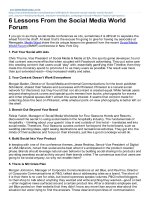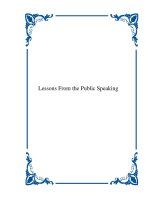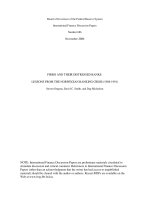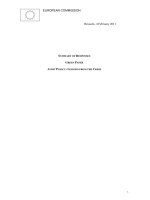Air Force Procurement Workforce Transformation - Lessons from the Commercial Sector pptx
Bạn đang xem bản rút gọn của tài liệu. Xem và tải ngay bản đầy đủ của tài liệu tại đây (472.74 KB, 118 trang )
This PDF document was made available
from
www.rand.org as a public service of
the RAND Corporation.
6
Jump down to document
Visit RAND at www.rand.org
Explore RAND Project AIR FORCE
View document details
This document and trademark(s) contained herein are protected by law
as indicated in a notice appearing later in this work. This electronic
representation of RAND intellectual property is provided for non-
commercial use only. Permission is required from RAND to reproduce, or
reuse in another form, any of our research documents.
Limited Electronic Distribution Rights
For More Information
CHILD POLICY
CIVIL JUSTICE
EDUCATIO
N
ENERGY AND ENVIRONMENT
HEALTH AND HEALTH CAR
E
INTERNATIONAL AFFAIR
S
NATIONAL SECURIT
Y
POPULATION AND AGIN
G
PUBLIC SAFETY
SCIENCE AND TECHNOLOGY
SUBSTANCE ABUSE
TERRORISM AND
HOMELAND SECURITY
TRANSPORTATION AND
INFRASTRUCTURE
The RAND Corporation is a nonprofit
research organization providing
objective analysis and effective
solutions that address the challenges
facing the public and private sectors
around the world.
Purchase this document
Browse Books & Publications
Make a charitable contribution
Support RAND
This product is part of the RAND Corporation monograph series.
RAND monographs present major research findings that address the
challenges facing the public and private sectors. All RAND mono
-
graphs undergo rigorous peer review to ensure high standards for
research quality and objectivity.
Prepared for the United States Air Force
Approved for public release, distribution unlimited
Air Force
Procurement
Work
force
Transformation
Lessons from the Commercial Sector
John Ausink, Laura H. Baldwin, Christopher Paul
The RAND Corporation is a nonprofit research organization providing
objective analysis and effective solutions that address the challenges
facing the public and private sectors around the world. RAND’s
publications do not necessarily reflect the opinions of its research clients
and sponsors.
R
®
is a registered trademark.
© Copyright 2004 RAND Corporation
All rights reserved. No part of this book may be reproduced in any
form by any electronic or mechanical means (including photocopying,
recording, or information storage and retrieval) without permission in
writing from RAND.
Published 2004 by the RAND Corporation
1700 Main Street, P.O. Box 2138, Santa Monica, CA 90407-2138
1200 South Hayes Street, Arlington, VA 22202-5050
201 North Craig Street, Suite 202, Pittsburgh, PA 15213-1516
RAND URL: />To order RAND documents or to obtain additional information, contact
Distribution Services: Telephone: (310) 451-7002;
Fax: (310) 451-6915; Email:
Library of Congress Cataloging-in-Publication Data
Ausink, John A.
Air Force procurement workforce transformation : lessons from the commercial
sector / John Ausink, Laura Baldwin, Christopher Paul.
p. cm.
“MG-214.”
Includes bibliographical references.
ISBN 0-8330-3648-3 (pbk. : alk. paper)
1. United States. Air Force—Procurement. I. Baldwin, Laura H., 1967– II.
Paul, Christopher, 1971– III. Title.
UG1123.A85 2004
358.4'16212'0973—dc22
2004015452
The research reported here was sponsored by the United States
Air Force under Contract F49642-01-C-0003. Further information
may be obtained from the Strategic Planning Division, Directorate of
Plans, HqUSAF.
iii
Preface
Ongoing RAND Project AIR FORCE research is supporting the U.S.
Air Force’s efforts to change the way it purchases goods and services
to improve performance and reduce costs. There is a great deal of in-
terest in adopting proven commercial practices such as using cross-
functional teams (called commodity councils) to develop corporate-
wide strategies for purchasing categories of commodities. The Air
Force has begun a procurement transformation effort, focusing on
implementation of commodity councils and development of strate-
gies for selected types of commodities. A key tenet of the transforma-
tion effort is workforce development.
This report summarizes RAND Corporation support for the Air
Force’s procurement workforce transformation efforts. The purpose
of this research is to provide preliminary analyses to aid the Air Force
with some of the human-capital-related aspects of its procurement
transformation efforts. In this document, we draw on insights from
commercial sector experiences with implementation of commodity
councils and new purchasing and supply management strategies for
procurement of goods and services. We describe skills that Air Force
procurement personnel will need for effective participation in com-
modity councils and make an initial assessment of new skills that will
need to be developed, discuss selected commercial practices on train-
ing for purchasing and supply management professionals, and rec-
ommend a portfolio of performance metrics the Air Force could use
to track the progress of and refine its procurement workforce trans-
formation efforts.
iv Air Force Procurement Workforce Transformation
This research is part of a broader study entitled “Supporting Air
Force Procurement Transformation and Laying the Groundwork for
Services Acquisition Reform,” sponsored by the Air Force Deputy
Assistant Secretary for Contracting (SAF/AQC) and conducted
within the Resource Management Program of RAND Project AIR
FORCE.
Other RAND Project AIR FORCE research is supporting the
Air Force Materiel Command’s purchasing and supply management
demonstration efforts within its Air Logistics Centers, as well as the
restructuring of the command’s headquarters organizations around
the principles of purchasing and supply management.
This document should be of interest to all federal agency per-
sonnel concerned with significant changes in workforce activities and
skills, particularly changes associated with implementation of pur-
chasing and supply management activities.
For the last decade, RAND Project AIR FORCE has been
helping the Air Force reshape its sourcing policies and practices. The
reader may also be interested in the following related RAND Corpo-
ration reports (which are available on the web, see www.rand.org/
Abstracts):
• Using a Spend Analysis to Help Identify Prospective Air Force Pur-
chasing and Supply Initiatives: Summary of Selected Findings,
Nancy Y. Moore, Cynthia Cook, Charles Lindenblatt, and
Clifford Grammich, DB-434-AF, 2004.
• Measuring Changes in Service Costs to Meet the Requirements of
the 2002 National Defense Authorization Act, Chad Shirley, John
Ausink, and Laura H. Baldwin, MR-1821-AF, 2004.
• Defining Needs and Managing Performance of Installation Support
Contracts: Perspectives from the Commercial Sector, Laura H.
Baldwin and Sarah Hunter, MR-1812-AF, 2004.
• Implementing Performance-Based Services Acquisition (PBSA):
Perspectives from an Air Logistics Center and a Product Center,
John Ausink, Laura H. Baldwin, Sarah Hunter, and Chad
Shirley, DB-388-AF, 2002.
Preface v
• Implementing Best Purchasing and Supply Management Practices:
Lessons from Innovative Commercial Firms, Nancy Y. Moore,
Laura H. Baldwin, Frank Camm, and Cynthia R. Cook, DB-
334-AF, 2002.
• Federal Contract Bundling: A Framework for Making and Justify-
ing Decisions for Purchased Services, Laura H. Baldwin, Frank
Camm, and Nancy Y. Moore, MR-1224-AF, 2001.
• Performance-Based Contracting in the Air Force: A Report on Expe-
riences in the Field, John Ausink, Frank Camm, and Charles
Cannon, DB-342-AF, 2001.
• Strategic Sourcing: Measuring and Managing Performance, Laura
H. Baldwin, Frank Camm, and Nancy Y. Moore, DB-287-AF,
2000.
• Incentives to Undertake Sourcing Studies in the Air Force, Laura
H. Baldwin, Frank Camm, Edward G. Keating, and Ellen M.
Pint, DB-240-AF, 1998.
• Strategic Sourcing: Theory and Evidence from Economics and Busi-
ness Management, Ellen M. Pint and Laura H. Baldwin, MR-
865-AF, 1997.
RAND Project AIR FORCE
RAND Project AIR FORCE (PAF), a division of the RAND Corpo-
ration, is the U.S. Air Force’s federally funded research and develop-
ment center for studies and analyses. PAF provides the Air Force with
independent analyses of policy alternatives affecting the development,
employment, combat readiness, and support of current and future
aerospace forces. Research is conducted in four programs: Aerospace
Force Development; Manpower, Personnel, and Training; Resource
Management; and Strategy and Doctrine.
Additional information about PAF is available on our web site at
/>
vii
Contents
Preface iii
Figures
xi
Tables
xiii
Summary
xv
Acknowledgments
xxi
Abbreviations and Acronyms
xxiii
CHAPTER ONE
Introduction 1
Background
1
Research Approach
5
Preview of Findings
6
Organization of the Report
7
CHAPTER TWO
An Analysis of Activities and Skills for the Air Force’s Future
Procurement Workforce
9
Information Sources
10
Commodity Councils and Their Activities
10
Skills Needed for Commodity Council Members
14
Sufficiency of Current Air Force and DoD Training for Commodity
Council Skills
15
DAU Curriculum
15
AFIT Curriculum
16
Assessment of Current Training
17
viii Air Force Procurement Workforce Transformation
CHAPTER THREE
Commercial Sector Training for Purchasing and Supply Management
Professionals
21
Guiding Principles for Purchasing and Supply Management Training
Programs
21
Examples from the Literature
24
SmithKline Beecham
24
Harley-Davidson
25
United Technologies Corporation
26
Examples from Interviews
27
Firm A
27
Firm B
28
Synthesis of Findings
30
CHAPTER FOUR
Metrics for Air Force Procurement Workforce Transformation 33
Metrics Framework
34
Metrics for Level Two: Contracting Outcomes
35
Contract-Level Outcomes
36
Effectiveness and Efficiency of the Contracting Organization
40
Metrics for Level Three: Application Outcomes
41
Implementation of Purchasing and Supply Management Activities
42
Metrics for Level Four: Individual Learning Outcomes
45
Standardized Testing
45
Subjective Evaluation
46
Metrics for Level Five: Training Outcomes
47
Training Quality
47
Provision of Training
49
Overarching Considerations
49
CHAPTER FIVE
Summary and Directions for Future Research 51
Summary
51
Topics for Future Research
52
Contents ix
APPENDIX
A. Detailed Lists of Commodity Council Activities 55
B. Detailed List of Skills for Commodity Council Activities
61
C. Mapping of Activities to Specific Skills
65
D. DAU and AFIT Training Assessment Approach
73
E. Defense Procurement “Competency” List for the 21st Century
Acquisition Workforce
75
F. Training Methods, Training Resources, and Organizations
That Offer Training
81
Bibliography
87
xi
Figures
3.1. O’Driscoll’s (2003) Architecture Plan 23
4.1. Hierarchy of Outcomes for Air Force Procurement Workforce
Transformation
35
xiii
Tables
4.1. Summary of Recommended Metrics and Potential Data
Sources for Level Two, Contracting Outcomes
41
4.2. Summary of Recommended Metrics and Potential Data
Sources for Level Three, Application Outcomes
44
4.3. Summary of Recommended Metrics and Potential Data
Sources for Level Four, Individual Learning Outcomes
47
4.4. Summary of Recommended Metrics and Potential Data
Sources for Level Five, Training Outcomes
49
A.1. Activities Associated with Laying the Groundwork,
by Commodity Class
56
A.2. Activities Associated with Conducting Analyses
57
A.3. Activities Associated with Sourcing Strategy
Recommendations
58
A.4. Sourcing Implementation Activities
60
B.1. Skills Needed for Commodity Council Activities
61
C.1. Activities and Skills for Laying the Groundwork,
by Commodity Class
66
C.2. Activities and Skills for Conducting Analyses
67
C.3. Activities and Skills for Sourcing Strategy Recommendations
68
C.4. Activities and Skills for Sourcing Implementation
70
xv
Summary
Air Force Procurement Transformation
The Air Force is in the process of significantly changing the way it
purchases goods and services, with the goals of reducing costs and
increasing performance to better support its missions. During spring
2002, SAF/AQC developed a Procurement Transformation Strategy
that outlines a roadmap for changing the Air Force’s procurement
policies, processes, personnel, and related technologies to meet the
changing needs of a transforming Air Force. A procurement trans-
formation division (SAF/AQCA) was created to lead these implemen-
tation efforts, and the new division highlighted two related areas for
particular emphasis: (1) implementation of cross-functional teams
(commodity councils) to develop strategies for individual commodity
groups and (2) procurement workforce development to support im-
plementation. These efforts involve designing a commodity council
approach for the Air Force, analyzing data to identify appropriate
commodity groups, identifying skills needed for council members to
effectively participate in council activities, analyzing current
workforce skills and training and identifying any gaps, and develop-
ing a plan to grow skills that are lacking.
PAF was asked to conduct three analyses to assist with these ef-
forts:
• Review ongoing research, industry publications, and other avail-
able sources on the transformation of commercial purchasing and
supply management practices and organizations to identify the
xvi Air Force Procurement Workforce Transformation
skill set needed by Air Force procurement personnel to success-
fully implement commodity councils. Then conduct a prelimi-
nary evaluation of current Air Force procurement skills to iden-
tify any gaps.
• To help the Air Force efficiently and effectively address any
identified training needs, gather information about how com-
mercial firms provide purchasing and supply management
training, as well as concrete examples of training programs and
publicly available courses.
• To help ensure that workforce transformation efforts are success-
ful, develop a portfolio of performance metrics that will facilitate
evaluation of progress and refinement of implementation plans
as needed.
This report describes our findings and recommendations based
on these analyses.
Research Approach
This research draws from a variety of private sector, Air Force, and
Department of Defense sources. We reviewed a sample of the litera-
ture on accepted purchasing and supply management practices, inter-
viewed commercial sector purchasing professionals, held discussions
with Air Force acquisition and training professionals, and reviewed
training curricula available to Air Force acquisition personnel. Based
on these sources, our analysis reaches the following conclusions with
attendant recommendations.
Commodity Councils Require a Wide Range of Skills
We find that commodity council membership requires a wide range
of skills (see Chapter Two), including use of computers, team-
ing/interpersonal skills, business skills such as creative problem solv-
Summary xvii
ing, core purchasing and supply management skills such as cost analy-
sis, analytical and technical skills such as statistical analysis, and con-
tracting skills (see pp. 14–15).
Based on our preliminary assessment of available training, it ap-
pears that additional training, as well as increased access to selected
existing Air Force Institute of Technology (AFIT) graduate courses,
will be needed to grow the full set of skills required for Air Force
commodity council members (see pp. 17–20).
Specifically, we recommend that the Air Force further refine the
list of skills required for commodity council members (found in Ap-
pendix B), based on the experiences of its prototype commodity
council. Once skill needs are comprehensively identified, a detailed
evaluation of the goals and content of the new Defense Acquisition
University (DAU) and AFIT curricula will be required to identify any
new types of training needed to build those skills (see p. 19). Oppor-
tunities to attend these new or improved courses will need to be in-
creased as the commodity council approach becomes widespread.
As an alternative to developing additional “in-house” training,
there are many existing course offerings that are utilized and endorsed
by well-respected commercial sector purchasing and supply manage-
ment organizations that the Air Force could consider (see pp. 19–20).
There Is No Single Answer to Procurement Training
Our literature review and interviews (discussed in Chapter Three)
suggest that commercial firms have also struggled to grow purchasing
and supply management organizations that contain the needed mix of
skills and expertise.
We find that while there is no single right way to implement
training, there are some common characteristics. Successful training
programs tend to be multifunctional, involving personnel with di-
verse backgrounds that are relevant to new practices (see p. 22). Dif-
ferent firms’ training programs are organized differently, some relying
on structured classroom or web-based learning to instill a basic un-
derstanding of a broad range of concepts, while others use more-
xviii Air Force Procurement Workforce Transformation
applied forms of learning such as formal on-the-job training and
mentoring programs to develop more-sophisticated capabilities and
high levels of expertise (see pp. 82–84). Finally, we note that different
types of training are appropriate for developing different levels of ex-
pertise (see pp. 22–23).
All of our findings from the literature and in current business
practice are consonant with two central themes (p. 22): First, training
must prepare purchasing and supply management personnel for the
realities of the current and continuously evolving environment in
which they work; as such, training and training program develop-
ment are always ongoing. Second, training should reflect the fact that
a traditional “functional” perspective is less useful in today’s business
environment, which rewards broadened perspectives; training that is
cross-functional and emphasizes process management is ideal to sup-
port an integrated approach to procurement.
This overall perspective suggests that procurement training
should be offered to a wider range of personnel than those tradition-
ally considered core procurement personnel and that training pro-
grams should have tiers of instruction provided through multiple
modes and approaches that depend on the desired level of mastery of
a given topic and the starting level of competence demonstrated by
individual students (pp. 30–31).
Effective Metrics Link Practices to Outcomes
Metrics facilitate evaluation of workforce development progress and
aid in the identification of areas for further improvement. In Chapter
Four, we identify a hierarchy of five levels of interests to monitor with
appropriate metrics (pp. 34–35): Air Force outcomes associated with
mission performance (Level One), contracting performance and cost
outcomes (Level Two), application outcomes associated with per-
formance of desired purchasing and supply management activities
(Level Three), individual learning outcomes associated with mastery
of desired skills (Level Four), and training outcomes (Level Five).
This framework explicitly links training to mastery of desired skills, to
Summary xix
appropriate implementation of desired purchasing and supply man-
agement activities, to improved outcomes of purchased goods and
services, and to the effectiveness and efficiency of the procurement
organization itself. We identify and recommend metrics for all levels
except Air Force/mission level outcomes, which are affected by a host
of factors other than contract performance.
In each case, metrics should be revisited over time to ensure that
they are providing needed information and that they remain aligned
with organizational objectives. In addition, the cost of implementing
individual metrics should be assessed relative to the value of the in-
formation provided (pp. 49–50).
xxi
Acknowledgments
We would like to thank Judy Lesso in the RAND library who was
instrumental in helping with the literature review for this report. Our
RAND colleagues Justin Adams, Frank Camm, Mary Chenoweth,
Eric Eide, Nancy Moore, Nancy Nicosia, and Bob Roll provided
helpful discussions and comments on an early draft of this document.
We would also like to thank the three private sector purchasing
professionals who helped us understand how they organize purchas-
ing and supply management training and how they use performance
metrics to manage their purchasing and supply management activities
and organizations. Assurances of anonymity prevent us from identi-
fying them here.
Many Air Force personnel assisted us in this research. We would
like to thank Lt Col Tom Gaylord, Deb Middleton, Dorothy Priest,
and Lt Pam Woods of the Air Force’s new Information Technology
Commodity Council for sharing their views on skills needed for fu-
ture Air Force commodity councils. Barry Bertie provided informa-
tion about AFIT’s short courses.
Our Air Force points of contact in SAF/AQCA, Dan Bowman,
Vince McDade, Lt Col Tim Reed, Maj David Reese, Maj Gloria Por-
ter, and Capt Jennifer Grant, helped us better understand the Air
Force’s procurement transformation efforts and how our research
could best support those efforts. John Caporal and Dianne Holmes,
SAF/AQCX, helped us understand related internal SAF/AQC efforts
to provide a baseline for current contracting workforce skills.
xxii Air Force Procurement Workforce Transformation
In addition, Lyle Eesley and Debbie Bartlett of DAU provided
valuable information about DAU’s new contracting curriculum.
We thank ManMohan S. Sodhi and Sheila Murray for their
helpful reviews of an early draft of this document. This document
benefited greatly from their suggestions.
Finally, we thank our administrative assistants, Maria Falvo and
Mary DeBold, for their document support.
xxiii
Abbreviations and Acronyms
AFIT Air Force Institute of Technology
AFMC Air Force Materiel Command
APDP Acquisition Professional Development Program
APICS American Production and Inventory Control Society
APP Accredited Purchasing Practitioner
ASTD America Society for Training and Development
CAPS Center for Advanced Purchasing Studies
CFETP Career Field Education and Training Plan
CPIM Certified in Production and Inventory Management
CPM Certified Purchasing Manager
DAU Defense Acquisition University
DoD Department of Defense
ISM Institute for Supply Management
MRP Materials Requirements Planning
NAPM National Association of Purchasing Management
OJT On-the-Job Training
SAF/AQC Air Force Deputy Assistant Secretary for Contracting
SCM Supply Chain Management
UTC United Technologies Corporation









